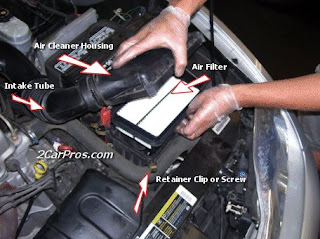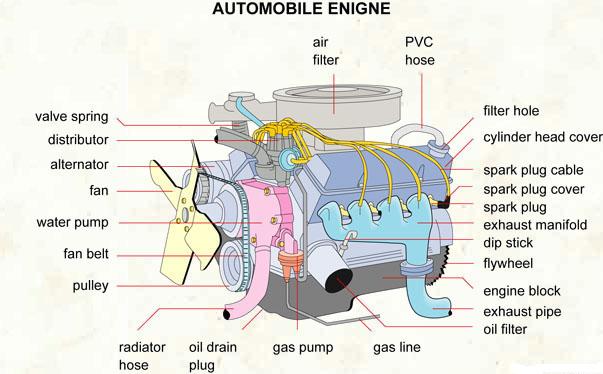1. Do you know how a basic engine works? What are its In’s & Out’s?
2. Do you know how many types of engines exist?
I might very well be insulting your intelligence by asking these questions, but come on, I'm pretty sure there will be a thing or two in this post that you will learn for the first time :)
So Happy Reading.....
Question Number 1
Ladies ( if any are reading this.. Hopefully they are..) & Gentleman.. Here’s to the basic functionality of the Four stoke engine.
Sub- Section 1 - The Anatomy of the Cylinder
If you may, please direct your attention to the image to your immediate Right.

You might notice the lettering and the colouring on the different parts of the diagram.
If you keep track of these colours you'll pretty much understand how the engine works.
The basic concept of an engine is to create a force large enough to move it self + anything else we might put onto it. So how does it create movement by using Petrol. The answer is an "EXPLOSION". Yes a series of "CONTROLLED" explosions move the car forward
I (Blue) - The intake valve, which sucks in cold air into the piston chamber
S - The Spark Plug used to trigger the explosion to burn petrol
E (Red) - The Exhaust value, used to take the waste gas after the burning of petrol away from the piston chamber
P (Yellow) - Is the piston, Movement is vertical ( Up & Down)
C (Purple) - The Crankshaft- This is connected through the gear box to the wheels
W (Green) - Water takes away the unwanted heat generated by the explosion of petrol to the outsides of the car.
Grey Area - Cast Iron/ Steel/ Aluminum Engine Block
Understood the basic anatomy of the engine???
Now lets move to the Next Sub Section
Sub Section 2 - How it Works
 Very basically how it works is in a 4 step process called a 4 stroke cycle.
Very basically how it works is in a 4 step process called a 4 stroke cycle.OK lets begin with STROKE 1
Stroke 1- (Piston Movement Top to Bottom) The Piston moves from Top to Bottom of the Cylinder. The Intake value is left open when this happens. The result, a cold mixture of gaseous petrol & air is sucked in from outside as the piston moves down. When the piston reaches the bottom of the cylinder it is full of the mixture. Now its ready for Stroke 2
Stroke 2- (Piston Movement Bottom to Top) The intake value is now closed. The Piston moves upwards compressing the Petrol air mixture to a tiny space as shown in the figure.
Stroke 3 - (Piston Movement Top to Bottom) The Spark Plug fires a spark and BANG!!!!!. The Spark causes the petrol air mixture to explode casuing a sudden expansion of gases exerting a massive power inside the cylinder. The force results in the movement of the only movable part inside the cylinder (The Piston) to move downwards making the crankshaft turn & deliver power to the wheels.
Stroke 4 - ( Piston Movement Bottom to Top) The Exhaust Value opens and as the piston is pushed upwards the exhaust gases leaves the chamber as the piston comes to the top and the exhaust value closes. Now its ready to do Stroke 1 again.
Theses four strokes combined is athermodynamic cycle called "Otto Cycle". The cycle continues over and over and over again at a speed enough to create thousands of revolutions per minute.
Sub Section 3 - Functionality Aids
 |
| Basic Air Filter Location |
The atmosphere around us is filled with dust particles and basically all sorts of stuff which can cause damage to the engine. The best way to prevent this is to ensure that the breathing system of the car is fixed to an air filter. Every car has air filter.
 |
| Carburetor |
So once the air gets filtered in through the air filter, it then has to be mixed in with petrol in order to form the explodable formula. This job is done by a carburetor. The petrol is atomized into the air in the carburetor to form the petrol air mixture, which is then fed into the intake system. In modern day cars however they use a system called EFI (Electronic Fuel Injection System), where the petrol is injected into the intake pipe just before the entrance into the cylinder and atomized there.This method is actually more fuel efficient.
 |
| Spark Plug |
Dangerous fellows those spark plugs...
 | |
| Distribution Hub |
So the 10,000 volts actually begs another question, Where does all this power come from?? If we were to trace our steps backwards from the spark plug we will be going along high conductible wires to something called a distributor. This is where the power is divided into separate wires for each cylinder spark plug. If you take a peak under you bonnet its actually the heavily insulated pieces with thick black wires coming out of it. The distributor is connected to the alternator which is kind of like a dynamo that generates electricity when the engine is turning.
 |
| Alternator |
 | |
| Radiator |
 |
| Water Pump |
Question Number 2
I think you had enough for today. So...
Another Day, Another Time.....




No comments:
Post a Comment